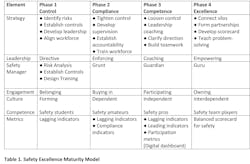Do you think you know where your organization is on your journey to safety excellence? Do you think you know where to go next and how to proceed? How would you like to stop thinking and start knowing?
For years our clients have told us their supposed status based on improved lagging indicators, benchmarking, program metrics and the standard “feel” for progress. Some are measuring activities such as audits, observations, meetings, training and more, seeking another metric to indicate status or progress. Some have failed to explore any metrics except lagging indicators and simply trend those metrics. It is amazing how many organizations have a chart of decreasing accidents that they believe show how successful they have been, not realizing their rate of decrease is less than the national average.
Navigation from one location to another requires several pieces of information: your current location, the location of your destination, the path between and mode of transportation. To progress in safety performance, you need to know the equivalent of these things: your current status, your desired status, and the way you plan to get from one to the other.
However, in the pursuit of safety excellence we need to take Covey’s advice and begin with the end in mind. What does safety excellence look like? The absence of a complete vision of safety success has doomed efforts to simply attempt to avoid failure. You definitely know what failure looks like and it is not what you want. But success is more than the absence of failure. Zero accidents, unless it is permanent, does not necessarily come from excellence. It can also come from luck, normal variation, or even the suppressing of reporting.
One reason you have not created an accurate and functional definition of safety excellence is because you have not envisioned its basic elements. Zero accidents is not a strategy and is not a proactive goal; it is the result of other things, and failing to address those things limits the chance of success. We studied our most successful safety clients and found several common elements to their efforts, some or all of which were missing in organizations with lesser or poor safety results. Chief among these elements of safety excellence are: a strong safety strategy, effective safety leadership, universal employee engagement in safety, a strong safety culture, and metrics to measure and understand each of these elements.
Excellence in each of these elements is accomplished in steps or stages, not all at once. Some have described the progression of one of these elements, safety culture, as going through stages. After the culture goes through a forming stage, it is often dependent: needing to be told what to do. It can then progress to being independent: knowing what to do, and able to function individually. If it continues to excellence, it becomes interdependent: team based, cooperative and synergistic.
If you think of culture as being influenced by the other elements, you can graph out how each of the others must progress in order for culture to transition from stage to stage. For example, a culture will not progress from dependent to independent if leaders and supervisors remain micromanagers telling everyone what to do.
Recent research has revealed that visible progress toward a goal is both informational and motivational. The United Way group of charities learned through years of trial and error to put up their famous graphic that looked like a thermometer or rain gauge which filled up from the bottom toward its goal at the top. Employees saw their progress regularly and knew what was still needed to meet the goal. It both informed and motivated. Such a graphic is needed in safety. Everyone in the organization needs to be goal-oriented and progress-driven, and lagging indicators don’t help either.
In order to create a graphic metric of your current status, you need to measure your performance in each of these areas against the element’s definition of excellence. A grid of the elements in each stage can be created beginning from left to right or bottom to top. Progress through the stages of each can be determined by assessing the characteristics of the stage that has been mastered. The remaining grids define the ideal path forward toward excellence.
In most organizations, it will be important to keep progress for each element as close to the other elements as possible. Some organizations will already be quite excellent at some elements but not at others. Rather than pressing forward with the excellent elements, it may be wise to catch the other elements up to keep a balanced approach to progress. If any elements lead the others by too much, it can tempt everyone to abandon the weak elements and work where progress is easiest and most visible. Complete neglect of any element or combination of elements almost always leads to future failure.
Table 1 is a grid with a few characteristics of each element at each stage. Table 2 is an example of an assessment of an organization in each element showing their progress, status, and the gap between their current performance and true excellence. Consider how this could become your GPS (graphic position of safety) and inform and motivate your workforce to continuously move toward safety excellence.
Table 2. Assessment Summary.
Terry Mathis, founder and CEO of ProAct Safety (www.proactsafety.com), has served as a consultant and advisor for top organizations the world over. A respected strategist and thought leader in the industry, Mathis has authored five books, numerous articles and blogs. EHS Today has named him one of the “50 People Who Most Influenced EHS” four times. He can be reached at [email protected] or 800-395-1347.
Figure 1. Safety Excellence Maturity Model.
(pick up from Jan/Feb 2019, page 5)
Figure 2. Assessment Summary.
(in folder)


